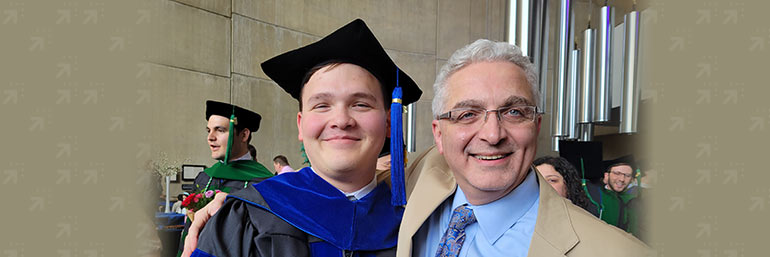May 15

Ph.D. candidate shares the joys of discovery and development of new knowledge
It’s going to be a busy summer for Ernesto Solorzano Zepada.
While he crossed the stage to receive his Ph.D. hood at the May 6 commencement ceremony, he will defend his dissertation in July.
And he will have a new baby in tow – he and his wife, Alyssa, are expecting their first child in June.
And he is exploring post-doc opportunities and awaiting word on a patent application.
Pursuing knowledge
Born and raised in Nicaragua, Solorzano moved to the United States to attend Walsh University, in North Canton, Ohio, where he earned a Bachelor of Science degree in biochemistry.
“We had a recruiter come to Nicaragua,” he explained. “We had a big cohort [at Walsh] of Latin American students that year.”
He came to NEOMED to hone his research skills.
“It’s always fun to learn new things,” he said. “When it comes to research, you get to learn more about [a topic]. Nobody else has done this before. You’re literally on the frontier of it. You’re creating new knowledge.”
He is especially interested in translational research, “not specifically looking at what this gene does, but more so, how can we move this from the bench to the bedside?” he said. “I’ve gotten a lot of support in that regard through my advisor [Fayez Safadi, Ph.D.].”
Working in Dr. Safadi’s lab, Solarzano became a member of the Saccavi team, which presented to the I-Corps@Ohio program, a statewide program to assist faculty and graduate students from Ohio universities and colleges to validate the market potential of their technologies, and was part of the NEOvations Bench to Bedside competition. The research team continues to develop Osteoactivin, a protein that activates bone regeneration.
“We’ve already done a lot of the development of tissue. We’re in the process of adapting toward the clinic and getting funding to start clinical trials,” he said. “This new technology is a way to isolate this growth vector from a patient. So it wouldn’t come from a lab. It would be minimally invasive.”
Current procedures are expensive and can lead to too much bone growth and low-quality bone growth. There is also a long healing time for patients.
“That’s what we are trying to address: to minimize healing time and improve bone growth,” Solorzano explained.
The team has applied for a patent for their innovative process.
Exploring anomolies
Though he has spent many hours in the lab exploring bone growth, his dissertation deals with bone loss from a rare disorder, complex lymphatic anomaly.
“It’s a rare disease where the lymphatic system invades the bone and makes it disappear,” Solorzano said. “It’s a mutation that happens when the patient is already born. It’s a very strange anomaly, because typically the lymphatic system and the bone don’t actually interact with each other.”
The condition, often triggered by some kind of trauma, has been reported in about 500 patients, mostly children, said Solorzano.
“There are variations of this lymphatic anomaly. One of the subtypes is very localized and very aggressive. A patient could lose an entire leg over a period of a few months,” he noted. “One of the reasons why I also lean into this disease is because really any research done is very impactful.”
With I-Corp funding, Solorzano has been exploring what happens when lymphatic cells are exposed to bone in cell cultures and animal models. It also gave him the opportunity to talk to patients, parents, physicians and researchers.
“It’s very scary for the patient, for the parents as well,” he noted. “When we do research here, it’s a lot of basic science. We work with animal models, we look at cell cultures. So it’s really easy to get detached from what we do and how is it relevant. This was a very good reminder of why I’m doing this.”
Advice for future students
What advice would he give to someone considering a Ph.D. program?
“When it comes to getting through a Ph.D. program, it will be hard,” he said matter-of-factly. “But it will be very rewarding because it is not something anybody does before they get here. You don’t just learn material. What you really gain from it is critical thinking. You really learn to think and question everything you see and do not know.
“Wherever I land, I’m confident I can land on my two feet, given enough time, because I can teach myself anything,” he added.
He also advised prospective Ph.D. students to never lose sight of the big picture.
“When you defend, when you present a topic, there is always a question that gets asked: Why does this matter? And some people can’t answer it,” he said. “Is it benefiting the general knowledge, which is a good goal as it is, or is it benefiting the human race? I like to benefit the human race.”


